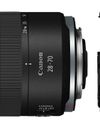
Canon released its full-frame mirrorless EOS R camera four years ago, in 2018, and while lenses for the new RF mount have steadily trickled out over the years, one optic we’d been pining for is a successor to the EF 100mm f/2.8L Macro IS USM.
Many Canon photographers who upgraded to mirrorless continued to use the trusty Canon EF 100mm prime with an EF-EOS R adapter, but now we finally have the native RF mount version, which comes with a raft of upgrades, including image quality improvements and features such as a 1:1.4 reproduction ratio, spherical aberration control, image stabilization, a focus limiter and much more.
A true macro lens has a reproduction ratio of 1:1 – this is called lifesize because it means your subject is reproduced at the same size as if it were placed across the imaging sensor of the camera. Canon’s RF 100mm F2.8L Macro IS USM lens not only goes to 1:1 for superb lifesize close-ups, but it can go as far as 1:1.4, so subjects can be photographed at 1.4x lifesize to reveal even more incredible detail – and can do so with an incredibly quiet autofocusing motor. The optic also features optical stabilization, and if paired with an EOS R body with IBIS (like the R5 or R6), grants a whopping 8-stops of stabilization when shooting handheld, making it ideal for shake-free shots if you don’t have a tripod handy.
Read on to see how you can get the most out of this macro lens on your mirrorless EOS R body.
THE SETUP HOW TO GET STARTED IN MACRO
A basic setup for mastering macro photography at home or in the garden
Bu hikaye PhotoPlus : The Canon Magazine dergisinin August 2022 sayısından alınmıştır.
Start your 7-day Magzter GOLD free trial to access thousands of curated premium stories, and 9,000+ magazines and newspapers.
Already a subscriber ? Giriş Yap
Bu hikaye PhotoPlus : The Canon Magazine dergisinin August 2022 sayısından alınmıştır.
Start your 7-day Magzter GOLD free trial to access thousands of curated premium stories, and 9,000+ magazines and newspapers.
Already a subscriber? Giriş Yap

The Art of Copying Art - James Paterson shows you how to use your Canon gear to capture artwork and paintings the right way with simple camera and lighting skills
Whether you want to capture a painting like the above, digitise old prints or reproduce any kind of canvas, there's real skill in capturing artwork with your camera. Not only do you need the colours to be accurate, you also need to master the spread, angle and quality of the light to minimise glare and show the work at its best.This painting by the artist Bryan Hanlon has a wonderfully subtle colour palette. To reproduce the painting in print and digital form, it needs to be captured in the right way.

Fright night
Canon photographer and digital artist Alexander loves to craft incredible fantasy scenes with a spooky horror twist

Sharpen your shots with DPP
Sharpening a digital image also increases contrast at the edge of details

CANON ImagePrograf PRO-1100
Deeper blacks, better bronzing, greater lifespan and 5G Wi-Fi -Canon's new printer is full of new tech, says

Canon's new 'kit lens' is actually a half-price f/2.8 trinity lens!
The Canon RF 28-70mm F2.8 IS STM lacks a red ring, but borrows premium features from its L-series siblings

DREW GIBSON
Pro motorsports photographer Drew on why he hasn't (yet) switched to Canon's mirrorless system, why old-school techniques can be the most reliable, and the lessons learned from more than a decade shooting the world's biggest car brands

Up in smoke
Make a smoky shape in Affinity Photo and get to grips with the amazing Liquify Persona under the guidance of James Paterson

Expand your creativity with Generative Fill
Photoshop's Al-powered feature brings revolutionary new tools to image editing. James Paterson reveals all...

Turn your images into vintage postcards
Wish you were here? Sean McCormack explains how you can give your summer photographs a vintage postcard look

The Angel Malibu
Light painting an American movie producer in the Wadi Rum Desert in Jordan was a highly unlikely evening out for David!